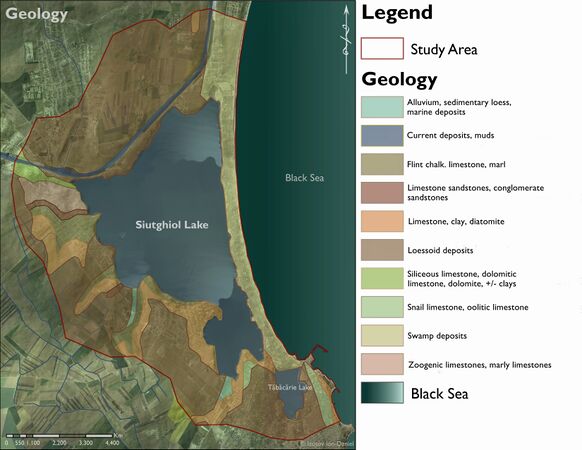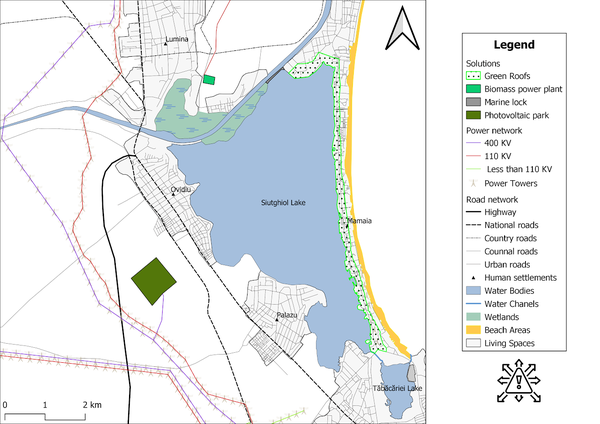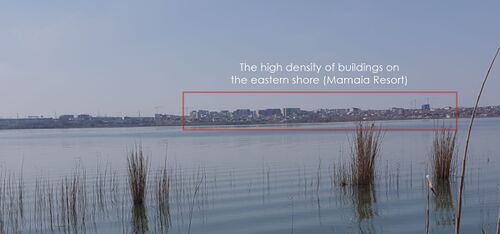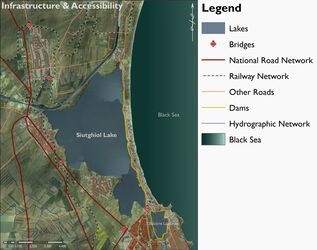Lacul Siutghiol Living Lab 2021: Difference between revisions
Ion.izotov (talk | contribs) |
Ion.izotov (talk | contribs) |
||
| Line 88: | Line 88: | ||
<gallery caption=" " widths="600px" heights="450px" perrow="5"> | <gallery caption=" " widths="600px" heights="450px" perrow="5"> | ||
File:Blue&GreenSiutghiol.png|'' | File:Blue&GreenSiutghiol.png|''Blue & Green Infrastructure Around the Siutghiol Lake © Mocanu Doru-Alexandru'' | ||
File:your case_green blue infrastructure2.jpg|''add a caption'' | File:your case_green blue infrastructure2.jpg|''add a caption'' | ||
</gallery> | </gallery> | ||
Revision as of 09:57, 29 April 2021
>>>back to working groups overview
Rationale
As the urbanization processes have speeded up around the world, every natural element nearby the metropolitan areas often end up being sacrificed for the sake of economy purposes and Siutghiol Lake is no stranger to that. Covering an area nearly as broad as the hostile city in the south (Constanța), the lake has suffered of habitats degradation due to irrational tourism, nearby factories, illegal building procedures and lack of interest from the local administration. It is very important to preserve the area, as the lake serves as an important migratory route of the birds through the Via Pontica and the Sarmatian Route. The aim of this study is to cover every important aspect which led to the deconstruction of something that once was a hospitable environment.
Location and scope
Water as a natural system
Geomorphology, typologies and dynamics of water areas
Located in Dobrogea, northern of the Constanța municipality, Siutghiol Lake (sütgöl meaning „milk lake” in Turkish) has an area of approximately 20 km² filled with 69.6 million m³ of water (Telteu, Zaharia, 2012), reaching the depth of 18 meters (according to Gâștescu) and a 7.82 meters depth according to more recent measurements. Geomorphologically speaking, the lake used to be a bay in the past, directly communicating with the Black Sea, but because of the wave action, abrasion, accumulation, local winds and marine currents, a 300-400 meters width and 9 km long sandspit was formed, where the Mamaia touristic resort lies now.
The local depressions were shaped during the later Jurassic and early Quaternary times (100-160 million years ago) all these mainly because of the marine abrasion. These days, Siutghiol communicates with the Black Sea through Tăbăcarie Lake (which is 20 km southward) through anthropic canals. It also supplies the upper lakes of Tașaul and Corbu with freshwater through canals (some sources claim that the water supply has been stopped in the past years). Nearby the western shore of Siutgiol lies a 2.6 ha island of limestone composition named after the roman poet Pūblius Ovidius Nāsō who apparently wrote some of his poetry on this island as he was exiled, however this is just a myth to attract tourism in the area.
The most common types of water in the area tend to be overshadowed by the presence of the Black Sea, however lagoons and limans are still a very typical sight of western Dobrogea. The genesis of the lakes is natural, but some anthropic changes occurred in the past centuries for a better function of the territory (canals, dams, bridges, roads and so on) action that speeded up the urbanization process. Natural rivers in the are are rare to be found because of the lack of high geomorphological units nearby (the closest geomorphological unit to a mountain range being in northern part of Dobrogea), however there are plenty of canals including the Danube-Black Sea Canal built to shorten the trade route on the Daube River by 400 km. Wet lands can be found in the proximity of the limans and the shore and serve as a habitat for the local species, however most of them started to be replaces with parking lots, buildings or landfills (Palazu Mare). In Tăbăcărie Lake, a part of the wastewater of the city of Constanța is discharged, which obviously led to mass losses of the natural biotope in the area as many birds species don't stop by the lake anymore on their migratory route.
Despite the fact that most of the water supplies in the Romanian lakes come directly from rainfalls or rivers, the main input of the western Dobrogean lakes are the groundwaters which allows the water level to be stable all year round, even if they're no longer connected to the Black Sea. The bedrock of Siutghiol is mainly formed from karst which allows an optimal interaction with the groundwaters. There are no tributaries as most of the rivers in this region drain directly in the Black Sea or the Danube. The lack of annual precipitations (around 400 mm) aren't enough to supply the Siutghiol Lake with freshwater at a constant rate, so other sources are needed.
The floodplain area is extended in the southern part of the Constanța Municipality, but when it comes to the Siutghiol Lake, the Mamaia Sandspit is the most vulnerable area to floods alongside the northern shore of the lake, where the slopes are low to non-existing. However, because of recent rehabilitation efforts (dams construction, tetrapods, etc.) the flood chances are very low as long as the ocean level remains stable. The Siutghiol’s catchment areas is estimated to cover an area of 71.6 km².
Due to the different water flow input in the local lakes and the anthropic needs that arose in the use of these lakes after 1950, several connecting canals were built between these lakes. Thus, through these canals, water transfers take place from Siutghiol Lake to Tăbăcăriei and from it to the sea, and also from Siutghiol through a pipeline to Tașaul. Subsequently, due to the increase in water consumption in Siutghiol and the regulation of leaks between Tașăul and Gargalâc and discharges into the sea (for Lake Gargalâc) this pipeline was closed in 1967. Level variations and climatic characteristics are very well reflected in the hydrological balance of Lake Siutghiol as over the years, the average lake level fluctuated from 115 cm to 225 cm and even more during the flood event.
Because of the relatively low elevation level, especially in northern part of Dobrogea, floods have been common for most of the time. However, as the time passed by and humanity developed engineering systems to stop the flooding phenomena to occur, the incidents slowed down or stopped. The lack of precipitations in the area also comes close by regarding this matter. For preventing future possible floods and the erosion caused by the waves action and by marine currents, the local administration has placed tetrapods near the shore in the proximity of human settlements. Despite all of this, because of the heavy rainfalls that sometimes occur in the region during the summertime, back in 2004 the people living nearby the coast have experienced floods for one day (28 August) and no other significant flood has been reported ever since. The only regions exposed to this matter are far from human settlements (at least in the southern Dobrogea). The plateau's geomorphological features prevent the city from experiencing such unfortunate events. However, the study area is more vulnerable to this due to recent climate changes and rise of the world oceans level which will affect the Black Sea as well, despite being a relatively guarded sea. The bay barrier of Mamaia is flat and doesn't even reach 2 meters height so it is very likely that in the future it might get back underwater if no action is taken.
- Yourcase watersystem2.jpg
add a caption
- Yourcase watersystem3.jpg
add a caption
Water as a living space
- Which habitats can be found in and along the water areas of your area?
- How is the water quality in your water areas?
- Which areas are still natural, which are urbanised/artificial?
- Are the rivers permeable for fish or blocked by artificial elements?(approx 200 signs)
- add 1-2 graphical representations to the image gallery, you can add more if you like
- Yourcase wateraslivingspace1.jpg
add a caption
- Yourcase wateraslivingspace2.jpg
add a caption
- Yourcase wateraslivingspace3.jpg
add a caption
Blue and Green Infrastructure
- What are the major potential elements of a green/blue infrastructure network? Are these likely to change/disappear? Why is that?
- You find my background material on green infrastructure in our reading list
- add 1-2 graphical representations to the image gallery, you can add more if you like
- Your case green blue infrastructure2.jpg
add a caption
Water as a cultural space
Land use and water
It's safe to say that the study area covers a wide variety of land and water use. Around the lake, the urban areas take the most part of the land and serve as either a residential purpose (Ovidiu, Palazu Mare, Constanța) or an entertainment one (on the eastern shore - Mamaia). There are some very small green urban areas which count the most to the total green region. The industrial or commercial units sit in Siutghiol's proximity as well and as mentioned before, some of their waste is disposed in the lake with little to none consequences. As for the natural side, there are a few inland marshes which don't cover a big part, a little area dedicated for pastures, the Danube-Black Sea Canal in the north and a transitional woodland-shrub area. Right before the northern entrance to the Constanța Municipality, there is a mineral extraction site which is still exploited to this day. The rest of the area is covered by the agriculture branch which extents to the nearby cities and it's a common sight in Dobrogea. The road network is not as developed as you would expect, but it is definitely present as the A2 Highway (also known as The Highway of the Sun) crosses the west side of the lake.
The forest zones are far gone as you can barely find any trees within the study area (there are a few between Ovidiu and Palazu Mare or in the green urban areas) and not because of the climate type or soil compositions, but because of high deforestation actions in the past decades. Some industrial units don't work anymore and there is a changing tendency to commercial units instead. The wild beaches that once were on the sandspit were replaced by the touristic resorts which is constantly expanding. The land and water use will definitely change in the near future as the urban areas extend in a worrying manner and the agriculture is slowly fading away. Authorities will most likely use every inch of the coastline if no action is being taken anytime soon. Despite its natural genesis, the Siutghiol Lake has definitely met high anthropic interventions as the time passed by and you can see its older days remains only in a few places now.
Cultural and spatial typologies of water areas
- Which spatial patterns have evolved in relation to your water areas?
- What is the role of water areas within the overall urban morphology? (approx 200 signs)
- add 1-2 graphical representations to the image gallery, you can add more if you like
- Yourcase water space1.jpg
add a caption
- Yourcase water space2.jpg
add a caption
- Yourcase water space3.jpg
add a caption
Sacred spaces and heritage
The Black Sea coast has been occupied by many civilizations over the time (Greeks, Romans, Ottomans and so on) so there is no surprise that they left a generous cultural heritage behind them. There is no well preserved archaeological site around the Siutghiol Lake, however you can still find some Paleolithic settlements in Mamaia Sat and Ovidiu that are set to be exposed soon by the archaeologists. You can also find a Roman-Byzantine fortifications on the western side of the lake, on a small promontory of the Ovidiu city and another one in Palazu Mare. There are no sites on the Mamaia sand-belt discovered most likely because it is a relatively new geomorphological formation and there was no point in building settlements on vulnerable and exposed land.
The irrational tourism, lack of investments into national cultural heritage preservation and misguided excavation actions by unqualified staff lead to the sites being forgotten in the local touristic routes and little to no attention is given to them. Because the cultural heritage is unable to recover once damaged, any rehabilitation action done by the archaeologists is highly restricted. The archaeo-tourism (tourists who practice thematic cultural routes) is often overshadowed in Dobrogea by the other local sights such as the Danube Delta and Măcin Mountains in the north, or the resorts in the south. However, despite not living on the high profile, it emerges only when it's needed to and if the right effort is put into it, then it can serve as a great economic resource to the community.
- You may add a map and some images, please also explain in your caption why these elements are valuable
- Your case sacredspace1.jpg
add a caption
- Your case sacredspace2.jpg
add a caption
- Your case sacredspace3.jpg
add a caption
Visual appearance and landscape narrative
Miron Costin claims the existence of a lake in the counties near the Dniester river, called either Owidowo, Vidovul, Ovidiului Lake, Lagoul Ovidouloui, Vidovo Lacus, Ovidovo Lacus or Vidovo Lake in different cartographical documents from various centuries. Many chroniclers, writers and poets have been writing about the Siutghiol Lake since the 16 th century. The lake was often mentioned in historic documents as well as travel guides and poems. Those who wrote about the lake often associated it with the name of the roman poet, Pūblius Ovidius Nāsō because, as the legend says, he was exiled by Emperor Augustus in 8 AD on a small island (link insula) located in Siutghiol Lake.
- 16 th century: Stanislav Sarnicius, Description of Russia, Poland and Livonia;
- 17 th century: Miron Costin, The Polish Chronicle - claims the existence of a lake in the counties near the Dniester river, called either Owidowo, Vidovul, Ovidiului Lake, Lagoul Ovidouloui, Vidovo Lacus, Ovidovo Lacus or Vidovo Lake in different cartographical documents from various centuries;
- 1769: Dimitrie Cantemir, Descriptio Moldaviae;
- 1802: Le Moniteur, Paris;
- 1836: Gheorghe Asachi, Ovid`s lake;
- 1857: Camille Allard, Mission médicale dans la Tatarie. Dobroutcha;
- 1885: Bruno Amante, Ovid in exile;
- 1908: Ion Adam, Pitoresque Constanta;
- 1924: Th. Ionescu, Constanta and Techirghiol Guide;
- 1971: Nicolae Lascu, Ovid. Man and poet.
Local legend: Once upon a time, where you can find Siutghiol Lake nowadays, there was a village full of bad people. Strangers were not welcomed there. On a festive day, when the villagers were celebrating in their homes, a man sneaked into the village. He asked many people to be let to stay overnight but without success. Seeing that no one is welcoming him, he decided to head to the edge of the village. He found there a small house made of stone where an old woman lived. She, unlike her neighbors, was kind and let the stranger stay as long as he wished to. The old woman was worried as she did not have anything to feast the man with. The traveler told her to put some manure in the furnace and so she did. The woman was astonished when she opened the furnace door as she found there an enormous bread that would become whole again after each bite. The next day, as the traveler left, water came out of nowhere and the village sunk. Everything was gone. Only the stone house remained and a crystal-clear lake formed.
The water is the central focus of this area along with the flora and fauna that depends on it on a long term, like the local plants and animals do, as well as on short-term, like the migratory birds that nest in this area.
- Your case character1.jpg
add a caption
- Your case character2.jpg
add a caption
- Your case character3.jpg
add a caption
Water and People
Accessibility and usability
The main access routes to reach the Siutghiol Lake by car are the Ovidius University campus in the south, , the whole Mamaia and Aurel Vlaicu Boulevard – not to mention the open space sand barrier where the Mamaia Resort lies - plus secondary thoroughfares such as Ovidius University, Jade and Border Alley, as well as other unmarked roads or natural ones. As mentioned before, the Siutghol Lake is accessible in certain areas such as the Mamaia Resort, or - on the southern shoreline - by Aqua Magic, part of the area near the Ovidius University. But the accessibility can also refer to areas where the lake can be admired in all of its glory, with or without the built infrastructure to serve the tourists such as hotels or restaurants. In terms of spatial obstacles, the constructions in general prevent the development of other activities along the lake shore - a matter easily noticed on the eastern coast where the buildings density is higher than it should be. Also, the lake has certain areas in Mamaia where it is not organized at all and presents possible dangers to the local biodiversity because of the household wastes.
The area of the Siutghiol Lake is mainly used by the local investors, who want to extend the resort as much as possible, in order to exploit the area economically. Of course, tourists are a common typology to be seen around the lake. Lately, this area has been used intensively for the development of mass tourism, by building hotels, restaurants, parks and other touristic sights. Another purpose for which this area is used is for leisure, boat trips, water sports, and in addition to these, fishing also takes place, an activity practiced by both amateurs and professionals. The area of Lake Siutghiol, belonging to the resort of Mamaia is used to own the JT Watersports water park, and it’s open only during summertime, next to being located the only floating restaurant in Mamaia, which is under construction. On the Ovidiu Island not many things are going on, there is a little restaurant and a wharf for the tourists.
Community Mapping
What is to be mapped here?
- Social groups from within the community, for example the youth, kids, students, parents, the retired etc. Typically, these groups have specific needs, which you can also make explicit on the map. These people might not be organized in any way, but they are usually present in the context you are observing
- Local stakeholder groups: these groups are organized in one or the other way. They only exist within the community context you are observing. For example: the local community center, local churches, local interest groups, the landowners, small businesses and retailers
- External stakeholder groups are not necessarily present in the environment you are observing, but they may have strong stakes and interests. These can be local authorities, politicians, associations, care services etc.
- For each group, you may identify their needs, objectives, power and capacities
- You may also identify gaps and power conflicts
- Please try to redepict these elements in an integrated way and in relation to your water landscape. What is the relationship between these groups? Are they close or distanced from each other? Who is more powerful? Which voices are hardly heard? Do they have any shared concerns?
- Your case your community map1.jpg
add a caption
- Your case your community map2.jpg
add a caption
- Your case your community map3.jpg
add a caption
Possible Futures
- You can summarize your findings with a SWOT diagram and a DPSI(R) Model
- Link back to the Sustainable Development Goals: Which goals are at risk?
- What is your worst case scenario for this landscape?
- What is your best case scenario for this landscape?
- Present your scenarios in the form of a collage or sketch
- Add text and visuals
- Your case your spider diagram or dpsir model.jpg
explain your analysis briefly in the caption
- Your case yourworstcase visual.jpg
explain your worst case scenario briefly in the caption
- Your case yourbestcase visual.jpg
explain your best case scenario briefly in the caption
Collaborative Goal Setting
- Define strategic planning objectives based on the evaluation findings from your analysis
- Ideally, involve the community of your living labs into this process
- Link back to your original targets from section one and the Development Goals
- 150 words text contribution
Spatial Strategy and Transect
- translate your strategic goals into a vision
- develop a spatial translation of your vision
- exemplify your vision in the form of a transect with concrete interventions
- add map(s) and visualizations
- Your case spatial translaton vision.jpg
add caption here
- Your case transect.jpg
add caption here
- Your case transect detail1.jpg
add caption here
- Your case transect detail2.jpg
add caption here
From Theory of Change to Implementation
- For implementing your vision: Which partnerships are needed? Which governance model is required?
- Who needs to act and how? Draw and explain a change/process model/timeline
- Which resources are needed? On which assets can you build?
- add 150 words text and visuals
References
- Arpenti, M.B., Pirjol, T.N., Ehlinger, T.J., Paraschiv, G.M., Tofan, L. (2014),Heavy Metal Content Analysis of Siutghiol Lake Water and Sedimen, Revista De Chimie, București.
- Gâștescu, P., Brețcan. P. (2003) Aspecte Privind Starea Actuală a Lacurilor Siutghiol și Techirghiol, Analele Universităţii „Valahia”, Seria Geografie, Târgoviște.
- Gâștescu, P., Brețcan. P., Teodorescu, D.C. (2016), The Lakes of the Romanian Black Sea Coast. Man-Induced Changes, Water Regime, Present State, Romanian Journal of Geography.
- Păsculescu, C.E. (2011) Aspects Regarding The Variability of the Levels of Siutghiol and Tăbăcărie Lakes, Present Environment and Sustainable Development, Vol. 5, no. 1, Bucharest.
- Telteu, C.E., Zaharia, L. (2012) Morphometrical and dynamical features of the South Dobrogea lakes, Romania, Elsevier, Bucharest.
- Catalogul Habitatelor, Speciilor și Siturilor Natura 2000 în România (2013) , Fundația Centrul Național pentru Dezvoltare Durabilă, București.
- Planul de Management al Riscului La Inundații (2014), Administrația Bazinală de Apă Dobrogea-Litoral.
Process Reflection
- Reflect in your intercultural and interdisciplinary team on the outcomes of your study
- Which limitations were you facing?
- What have you learnt from each other?
- What did you learn in the Living Labs?
- What would you do differently next time?
- You can also use diagrams/visuals
- 250 words text








